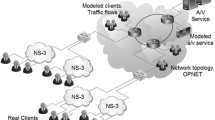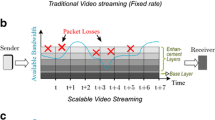Abstract
Due to the increasing deployment of conversational real-time applications like VoIP and videoconferencing, the Internet is today facing new challenges. Low end-to-end delay is a vital QoS requirement for these applications, and the best effort Internet architecture does not support this natively. The delay and packet loss statistics are directly coupled to the aggregated traffic characteristics when link utilization is close to saturation. In order to investigate the behavior and quality of such applications under heavy network load, it is therefore necessary to create genuine traffic patterns. Trace files of real compressed video and audio are text files containing the number of bytes per video and audio frame. These can serve as material to construct mathematical traffic models. They can also serve as traffic generators in network simulators since they determine the packet sizes and their time schedule. However, to inspect perceived quality, the compressed binary content is needed to ensure decoding of received media. The EvalVid streaming video tool-set enables this using a sophisticated reassembly engine. Nevertheless, there has been a lack of research solutions for rate adaptive media content. The Internet community fears a congestion collapse if the usage of non-adaptive media content continues to grow. This paper presents a solution named Evalvid-RA for the simulation of true rate adaptive video. The solution generates real rate adaptive MPEG-4 streaming traffic, using the quantizer scale for adjusting the sending rate. A feedback based VBR rate controller is used at simulation time, supporting TFRC and a proprietary congestion control system named P-AQM. Example ns-2 simulations of TFRC and P-AQM demonstrate Evalvid-RA’s capabilities in performing close-to-true rate adaptive codec operation with low complexity to enable the simulation of large networks with many adaptive media sources on a single computer.
Similar content being viewed by others
References
Palumbo, P.A.: Broadband streaming video: viewer metrics and market growth analysis 2000–2004. Accustream Research, Technical Report (2004)
UNINETT: Digital brytningstid uninett 10år. UNINETT, Technical Report. http://www.uninett.no/publikasjoner/digital.brytningstid/digital.brytningstid.pdf (2003)
ISO/IEC 13818-2, Information technology—generic coding of moving pictures and associated audio information – Part 2: Visual. (1994)
ISO/IEC 14496-2, Information technology—coding of audio-visual objects – Part 2: Visual (1999)
Li W. (2001). Overview of fine granularity scalability in MPEG-4 video standard. IEEE Trans. Circuits Syst. Video Technol. 11(3): 301–317
Wenger S., Wang Y.-K. and Hannuksela M.M. (2006). RTP payload format for H.264/SVC scalable video coding. J Zhejiang Univ 7(5): 657–667
Floyd S. and Fall K. (1999). Promoting the use of end-to-end congestion control in the Internet, IEEE/ACM Trans. Netw. 7(4): 458–472
Kohler, E., Handley, M., Floyd, S.: Datagram congestion control protocol (DCCP). IETF RFC4340, Technical Report http://www.ietf.org/rfc/rfc4340.txt (2006)
Floyd, S., Kohler, E., Padhye, J.: Profile for datagram congestion control protocol (DCCP) congestion control ID 3: TCP-friendly rate control (TFRC). IETF RFC4342, Technical Report http://www.ietf.org/rfc/rfc4342.txt (2006)
Lakshman, T.V., Mishra, P.P., Ramakrishnan, K.K.: Transporting compressed video over ATM networks with explicit rate feedback control. In: Proceedings of the INFOCOM’97 p.38 (1997)
Rejaie, R., Handley, M., Estrin, D.: RAP: an end-to-end rate-based congestion control mechanism for realtime streams in the internet. In: Proceedings of IEEE Infocom (1999)
Miyabayashi, M., Wakamiya, N., Murata, M., Miyahara, H.: MPEG-TFRCP: video transfer with TCP-friendly rate control protocol. In: Proceedings of IEEE International Conference on Communications (ICC2001) 1,137–141 (2001)
Sisalem, D., Wolisz, A.: LDA + TCP-friendly adaptation: a measurement and comparison study. In: Proceedings of NOSSDAV (2000)
Lie, A., Aamo, O.M., Rønningen, L.A.: A performance comparison study of DCCP and a method with non-binary congestion metrics for streaming media rate control. In: Proceedings of 19th International Teletraffic Congress (ITC’19), Beijing, China (2005)
Ramakrishnan, K., Floyd, S., Black, D.: The addition of explicit congestion notification (ECN) to IP. IETF RFC3198, Technical Report (2001)
Klaue, J., Rathke, B., Wolisz, A.: EvalVid—a framework for video transmission and quality evaluation. In: Proceedings of the 13th International Conference on Modelling Techniques and Tools for Computer Performance Evaluation, Urbana, Illinois, USA (2003)
Ke, C.-H.: How to evaluate MPEG video transmission using the NS2 simulator http://hpds.ee.ncku.edu.tw/~smallko/ns2/Evalvid_in_NS2.htm (2004)
Hamdi, M., Roberts, J.W., Rolin, P.: Rate control for VBR video coders in broad-band networks, IEEE J. Selected Areas Commun. 15(6) (1997)
Reibman A.R. and Haskell B.G. (1992). Constraints on variable bit-rate video for ATM networks. IEEE Trans. Circuits and Syst. Video Technol. 2(4): 361–372
Garrett, M., Willinger, W.: Analysis, modeling and generation of self-similar VBR video traffic. In: Proceedings of ACM sigcomm, London (1994)
Beran J., Sherman R., Taqqu M. and Willinger W. (1995). Long-range dependence in variable-bit-rate video traffic. IEEE Trans. Commun. 43(234): 1566–1579
Krunz, M., Tripathi, S.K.: On the characterization of VBR MPEG streams. In: Proceedings of ACM Sigmetrics’97. ACM, Seatle (1997)
Ansari, N., Liu H., Shi Y.Q.: On modeling MPEG video traffics. IEEE Trans. Broadcast. 48 (2002)
Liew, C.H., Kodikara, C., Kondoz, A.M.: Modelling of MPEG-4 encoded VBR video traffic. IEE Electron. Lett. 40(5) (2004)
Zhu, J., Matrawy, A., Lambadaris, I.: Models and tools for simulation of video transmission on wireless networks. In: Proceedings of IEEE Electrical and Computer Engineering (2004)
Mohsin, W., Siddiqi, M.: Scalable video transmission and congestion control using RTP. Department of Electrical Engineering, Stanford University, Technical Report (2002)
Xu, C., Liu, J., Zhao, C.: Performance analysis of transmitting H.263 over DCCP. In: IEEE International Workshop VLSI Design and Video Technology (2005)
Xu, L., Helzer, J.: Media streaming via TFRC: an analytical study of the impact of TFRC on user-perceived media quality. In: Proceedings of Infocom. (2006)
Gürses, E.: Optimal streaming of rate adaptable video. Ph.D. dissertation, The Graduate School Of Natural And Applied Sciences Of Middle East Technical University (2006)
Balan, H.V., Eggert, L., Niccolini, S., Brunner, M.: An Experimental Evaluation of Voice Quality over the Datagram Congestion Control protocol. NEC Europe, Germany, Technical Report (2006)
Wolf, S., Pinson, M.: Video quality measurement techniques. US Department of Commerce, NTIA, Technical Report 02-392 (2002)
Winkler S. (2005). Digital Video Quality—Vision Models and Metrics. Wiley, London
T1.801.03. Digital transport of one-way video signals—parameters for objective performance assessment. ANSI, Technical Report (2003)
Zink, M., Künzel, O., Schmitt, J., Steinmetz, R.: Subjective impression of variations in layer encoded videos. In: Proceedings of the 11th IEEE/IFIP International Workshop on Quality of Service (IWQoS’03), Monterey, CA, USA, pp. 134–154 (2003)
Gross J., Klaue J., Karl H. and Wolisz A. (2004). Cross-layer optimization of OFDM transmission systems for MPEG-4 video streaming. Comput. Commun. 27: 1044–1055
Wang Z., Bovik A.C., Sheikh H.R. and Simoncelli E.P. (2004). Image quality assessment: from error visibility to structural similarity, Image Process. IEEE Trans. 13(4): 600–612
VQM Software. http://www.its.bldrdoc.gov/n3/video/vqmsoftware.htm
JNDmetrix. http://www.sarnoff.com/products_services/video_vision/jndmetrix/
Ohm J.-R. (1995). Digitale Bildcodierung–Repräsentation, Kompression und Übertragung von Bildsignalen. Springer, New York
ISO/IEC/JTC1/SC29/WG11 14496: Information technology—coding of audiovisual objects. MPEG-4, (2001)
FFMPEG Multimedia System. http://ffmpeg.mplayerhq.hu/
Lakshman T., Ortega A. and Reibman A. (1998). VBR video: trade-offs and potentials. Proc. IEEE. 86(5): 952–973
Floyd, S., Kohler, E.: TCP friendly rate control (TFRC): the small-packet (SP) variant. IETF RFC4828, Technical Report. http://www.ietf.org/rfc/rfc4828.txt (2007)
Chung, J., Claypool, M.: Analysis of active queue management. In: Second IEEE International Symposium on Network Computing and Applications pp. 359–366 (2003)
Jain, R., Chiu D., Hawe W.: A quantitative measure of fairness and discrimination for resource allocation in shared systems. DEC Research Report TR-301, Technical Report (1984)
Katabi, D., Handley M., Rohrs C.: Congestion control for high bandwidth-delay product networks. In: Proceedings of ACM Sigcomm (2002)
Phelan, T.: TFRC with self-limiting sources. Sonus Networks, Technical Report http://www.phelan-4.com/dccp/tfrc-self-limit.pdf (2004)
Author information
Authors and Affiliations
Corresponding author
Rights and permissions
About this article
Cite this article
Lie, A., Klaue, J. Evalvid-RA: trace driven simulation of rate adaptive MPEG-4 VBR video. Multimedia Systems 14, 33–50 (2008). https://doi.org/10.1007/s00530-007-0110-0
Published:
Issue Date:
DOI: https://doi.org/10.1007/s00530-007-0110-0




